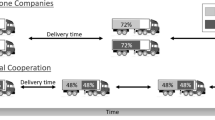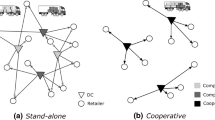Abstract
As customers are aware of the climate change, eco-friendly strategies have become a competitive advantage for companies. In particular, they are aiming to reduce their carbon footprint along their supply chain. In this context, substantial \(\hbox {CO}_{2}\) emissions reductions can be reached by horizontal cooperation, i.e. the collaboration of companies that work at the same level of the supply chain. In this paper, we evaluate these reductions using a location-inventory model which minimizes facility opening, transportation, cycle inventory, ordering and safety stock costs. To understand the impact of different market and partners characteristics on the \(\hbox {CO}_{2}\) emissions reductions, we compute a large set of numerical experiments, varying several key parameters (vehicles capacity, facility opening cost, inventory holding cost, order cost, demand variability and distances). Results show that horizontal cooperation reduces \(\hbox {CO}_{2}\) emissions by 16% on average. Moreover, horizontal cooperation is more effective in decreasing the carbon footprint of companies with low facility opening costs and low order costs, carrying expensive products (high unit holding cost) on a market with a high demand variability and a vast market area.


Similar content being viewed by others
Notes
The average distance traveled between a DC and retailer is computed as follows: \(\sum _{d,r}\frac{\varLambda _{r}}{Q_{dr}}\,D_{dr}\,y_{dr}/\sum _{d,r}\frac{\varLambda _{r}}{Q_{dr}}\,y_{dr}\).
References
Atamtürk A, Berenguer G, Shen ZJ (2012) A conic integer programming approach to stochastic joint location-inventory problems. Oper Res 60(2):366–381
Ballot E, Fontane F (2010) Reducing transportation \(\text{ CO }_{2}\) emissions through pooling of supply networks: perspectives from a case study in french retail chains. Prod Plann Control 21(6):640–650
Chaabane A, Ramudhin A, Paquet M (2012) Design of sustainable supply chains under the emission trading scheme. Int J Prod Econ 135(1):37–49
Chen L, Olhager J, Tang O (2014) Manufacturing facility location and sustainability: a literature review and research agenda. Int J Prod Econ 149:154–163
Christopher M (2016) Logistics and supply chain management. Pearson, London
Comas Martí JM, Tancrez JS, Seifert RW (2015) Carbon footprint and responsiveness trade-offs in supply chain network design. Int J Prod Econ 166:129–142
Creemers S, Woumans G, Boute R, Beliën J (2017) Tri-vizor uses an efficient algorithm to identify collaborative shipping opportunities. Interfaces 47(3):244–259
Cruijssen F (2006) Horizontal cooperation in transport and logistics. Thesis, CentER, Tilburg University
Cruijssen F, Cools M, Dullaert W (2007) Horizontal cooperation in logistics: opportunities and impediments. Transp Res E Logist Transp Rev 43(2):129–142
Cuervo DP, Vanovermeire C, Sörensen K (2016) Determining collaborative profits in coalitions formed by two partners with varying characteristics. Transp Res Part C Emerg Technol 70:171–184
Danloup N, Mirzabeiki V, Allaoui H, Goncalves G, Julien D, Mena C (2015) Reducing transportation greenhouse gas emissions with collaborative distribution: a case study. Manag Res Rev 38(10):1049–1067
Dekker R, Bloemhof J, Mallidis I (2012) Operations research for green logistics—an overview of aspects, issues, contributions and challenges. Eur J Oper Res 219(3):671–679
Diabat A, Abdallah T, Al-Refaie A, Svetinovic D, Govindan K (2013) Strategic closed-loop facility location problem with carbon market trading. IEEE Trans Eng Manag 60(2):398–408
Ergun O, Kuyzu G, Savelsbergh M (2007) Reducing truckload transportation costs through collaboration. Transp Sci 41(2):206–221
Fahimnia B, Sarkis J, Eshragh A (2015) A tradeoff model for green supply chain planning: a leanness-versus-greenness analysis. Omega 54:173–190
Farahani RZ, Rezapour S, Drezner T, Fallah S (2014) Competitive supply chain network design: an overview of classifications, models, solution techniques and applications. Omega 45:92–118
Farahani RZ, Rashidi Bajgan H, Fahimnia B, Kaviani M (2015) Location-inventory problem in supply chains: a modelling review. Int J Prod Res 53(12):3769–3788
Frisk M, Göthe-Lundgren M, Jörnsten K, Rönnqvist M (2010) Cost allocation in collaborative forest transportation. Eur J Oper Res 205(2):448–458
Hacardiaux T, Tancrez JS (2018) Assessing the benefits of horizontal cooperation using a location-inventory model, cORE Discussion Paper 2018/14, Université catholique de Louvain
Hageback C, Segerstedt A (2004) The need for co-distribution in rural areas: a study of Pajala in Sweden. Int J Prod Econ 89(2):153–163
Harris I, Mumford C, Naim M (2009) The multi-objective uncapacitated facility location problem for green logistics. In: IEEE congress on evolutionary computation, 2009. CEC’09. IEEE, pp 2732–2739
Harris I, Mumford CL, Naim MM (2011a) An evolutionary bi-objective approach to the capacitated facility location problem with cost and \(\text{ CO }_2\) emissions. In: Proceedings of the 13th annual conference on genetic and evolutionary computation, ACM, pp 697–704
Harris I, Naim M, Palmer A, Potter A, Mumford C (2011b) Assessing the impact of cost optimization based on infrastructure modeling on \(\text{ CO }_{2}\) emissions. Int J Prod Econ 131(1):313–321
Hickman J, Hassel D, Joumard R, Samaras Z, Sorenson S (1999) Methodology for calculating transport emissions and energy consumption. Transport Research Laboratory, Berkshire, United Kingdom
Juan AA, Faulin J, Pérez-Bernabeu E, Jozefowiez N (2014) Horizontal cooperation in vehicle routing problems with backhauling and environmental criteria. Proc Soc Behav Sci 111:1133–1141
Kaviani M (2009) Location-inventory problem, chap 19. In: Farahani RZ, Hekmatfar M (eds) Facility location: concepts, models, algorithms and case studies. Springer, Heidelberg, pp 451–471
Linton JD, Klassen R, Jayaraman V (2007) Sustainable supply chains: an introduction. J Oper Manag 25(6):1075–1082
Melo MT, Nickel S, Saldanha-Da-Gama F (2009) Facility location and supply chain management—a review. Eur J Oper Res 196(2):401–412
Moutaoukil A, Derrouiche R, Neubert G (2013) Modélisation d’une stratégie de mutualisation logistique en intégrant les objectifs de développement durable pour des PME agroalimentaires. In: 13e Congrès International de Génie Industriel (CIGI’13)
Moutaoukil A, Neubert G, Derrouiche R (2015) Urban Freight Distribution: The impact of delivery time on sustainability. IFAC-PapersOnLine 48(3):2368–2373
Nair KP (2016) The nutrient buffer power concept for sustainable agriculture. Notion Press, Chennai
Nozick LK, Turnquist MA (2001) A two-echelon inventory allocation and distribution center location analysis. Transp Res Part E Logist Transp Rev 37(6):425–441
Ouhader H, El Kyal M (2017) The impact of horizontal collaboration on \(\text{ CO }_{2}\) emissions due to road transportation. In: Proceedings of the international conference on industrial engineering and operations management
Özceylan E, Paksoy T (2013) A mixed integer programming model for a closed-loop supply-chain network. Int J Prod Res 51(3):718–734
Özceylan E, Paksoy T, Bektaş T (2014) Modeling and optimizing the integrated problem of closed-loop supply chain network design and disassembly line balancing. Transp Res Part E Logist Transp Rev 61:142–164
Pagell M, Wu Z (2009) Building a more complete theory of sustainable supply chain management using case studies of 10 exemplars. J Supply Chain Manag 45(2):37–56
Paksoy T, Özceylan E (2014) Environmentally conscious optimization of supply chain networks. J Oper Res Soc 65(6):855–872
Paksoy T, Bektaş T, Özceylan E (2011) Operational and environmental performance measures in a multi-product closed-loop supply chain. Transp Res Part E Logist Transp Rev 47(4):532–546
Paksoy T, Özceylan E, Weber GW (2013) Profit oriented supply chain network optimization. Central Eur J Oper Res 21(2):455–478
Pan S, Ballot E, Fontane F (2013) The reduction of greenhouse gas emissions from freight transport by pooling supply chains. Int J Prod Econ 143(1):86–94
Pérez-Bernabeu E, Juan AA, Faulin J, Barrios BB (2015) Horizontal cooperation in road transportation: a case illustrating savings in distances and greenhouse gas emissions. Int Trans Oper Res 22(3):585–606
Plambeck EL (2007) The greening of wal-mart’s supply chain. Supply Chain Manag Rev 11(5):18–25
Ramanathan V, Feng Y (2009) Air pollution, greenhouse gases and climate change: global and regional perspectives. Atmosp Environ 43(1):37–50
Rezapour S, Zanjirani Farahani R, Drezner T (2011) Strategic design of competing supply chain networks for inelastic demand. J Oper Res Soc 62(10):1784–1795
Rogelj J, Den Elzen M, Höhne N, Fransen T, Fekete H, Winkler H, Schaeffer R, Sha F, Riahi K, Meinshausen M (2016) Paris agreement climate proposals need a boost to keep warming well below \(2~^{\circ }C\). Nature 534(7609):631
Schuster Puga M, Tancrez JS (2017) A heuristic algorithm for solving large location-inventory problems with demand uncertainty. Eur J Oper Res 259(2):413–423
Seuring S (2013) A review of modeling approaches for sustainable supply chain management. Decis Support Syst 54(4):1513–1520
Seuring S, Müller M (2008) From a literature review to a conceptual framework for sustainable supply chain management. J Clean Product 16(15):1699–1710
Shen ZJM, Coullard C, Daskin MS (2003) A joint location-inventory model. Transp Sci 37(1):40–55
Soysal M, Bloemhof-Ruwaard JM, Haijema R, van der Vorst JG (2018) Modeling a green inventory routing problem for perishable products with horizontal collaboration. Comput Oper Res 89:168–182
Sundarakani B, De Souza R, Goh M, Wagner SM, Manikandan S (2010) Modeling carbon footprints across the supply chain. Int J Prod Econ 128(1):43–50
Tancrez JS, Lange JC, Semal P (2012) A location-inventory model for large three-level supply chains. Transp Res Part E Logist Transp Rev 48(2):485–502
UNFCCC (2015) Adoption of the Paris Agreement Report No. FCCC/CP/2015/L.9/Rev.1, http://unfccc.int/resource/docs/2015/cop21/eng/l09r01.pdf. Accessed 27 June 2018
Verdonck L, Beullens P, Caris A, Ramaekers K, Janssens GK (2016) Analysis of collaborative savings and cost allocation techniques for the cooperative carrier facility location problem. J Oper Res Soc 67(6):853–871
Zhang ZH, Unnikrishnan A (2016) A coordinated location-inventory problem in closed-loop supply chain. Transp Res Part B Methodol 89:127–148
Author information
Authors and Affiliations
Corresponding author
Additional information
Publisher's Note
Springer Nature remains neutral with regard to jurisdictional claims in published maps and institutional affiliations.
Rights and permissions
About this article
Cite this article
Hacardiaux, T., Tancrez, JS. Assessing the environmental benefits of horizontal cooperation using a location-inventory model. Cent Eur J Oper Res 28, 1363–1387 (2020). https://doi.org/10.1007/s10100-018-0599-7
Published:
Issue Date:
DOI: https://doi.org/10.1007/s10100-018-0599-7




